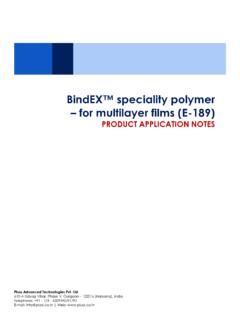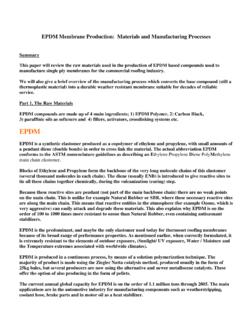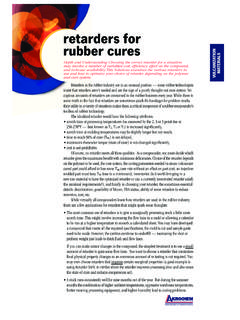Transcription of PolyCond: electromagnetic shielding with …
1 25 polycond : electromagnetic shielding with conducting polymersby Eddy BrinkmanFrom February 2005 to January 2009, about 20 European companies and organisations participated in the European Sixth Framework Programme research project polycond . The aim of this project was to develop high-value, environmentally friendly and low-cost conducting composites for protection against the effects of electromagnetic interference and electrostatic discharge. The project partners looked at plastics containing intrinsically conducting polymers such as polyaniline, and at conducting carbon nanotubes as filler in a non- conducting polymer matrix, as well as hybrid systems with combinations of both this: your mobile phone is lying on your desk, close to the speaker of your computer system. A few seconds before you receive a call or SMS message on your mobile phone, the speaker makes a buzzing noise.
2 Is this clairvoyance of the speaker? No way. Here, the wire to the speaker acts like an antenna that picks up and amplifies the signal it receives from the mobile phone network. This is a typical example of electromagnetic interference between electronic components, and it shows that electromagnetic fields are all around interferenceUnwanted electromagnetic interference effects occur when sensitive devices receive electromagnetic radiation that is being emitted whether intended or not by other electric or electronic devices such as microwaves, wireless computers, radios and mobile phones. As a result, the affected receiving devices may malfunction or fail, of which the malfunction of pacemakers when in the vicinity of certain electronic devices is a striking, yet detrimental, effects of electromagnetic interference are becoming more and more pronounced, caused by the demand for high-speed electronic devices operating at higher frequencies, the more intensive use of electronics in computers, communication equipment and cars, and the miniaturisation of these electronics.
3 For example, mobile phones and smartphones are typically operating at 800- 900 MHz, and around 2 GHz for data trans-mission through Universal Mobile Telecommunications Systems (UMTS). Compact, densely packed electronic components produce more electronic trends indicate the need to protect components against electromagnetic interference (EMI) in order to decrease the chances of these components adversely affecting each other or the outer world. The effects of electromagnetic interference can be reduced or diminished by positioning a shielding material between the source of the electromagnetic field and the sensitive component. This protection may be achieved by making the housing of electronic components electronically conducting . Electrical conductivity is a prerequisite for an EMI shielding material. This is due to the physical phenomenon that electric fields and varying magnetic fields induce currents in the electrically conducting shielding material.
4 In turn, these currents generate counteracting fields which weaken - or in the ideal case cancel - the originally applied fields. Ideally, external fields stay outside the shielding material, and internal fields stay inside. As EMI shielding is composed of reflection and absorption contributions, both the conductivity in the volume of the protecting material as well as the thickness of the material may be of importance. In a practical way, the extent of shielding is also subject to the size and shape of openings in the shield. For example, at a frequency of GHz the opening must be less than 2 mm for effective EMI is not only applicable to housings that separate electronic devices from the outside world. Also data cables can be shielded from their surroundings, for example, by a wire mesh encircling an inner core conductor as in an coaxial cable for transmission of radio and television frequency 2520-08-2009 15:56:3726 Very much related to EMI shielding is the protection against electrostatic discharge (ESD) in electronic devices.
5 ESD is the uncontrolled transfer of static charge between two objects with different electrical potential. For ESD protection surface conductivity is important, to allow a fast and controlled discharge of static for electromagnetic shieldingDue to their high electrical conductivity (order of magnitude 06 Siemens/cm), metals are particularly suitable as shielding material against electromagnetic fields. This can be a self-supporting full metal shielding , but also a sprayed, painted or electrolessly applied conducting coating ( nickel) on a supporting material such as plastic. Another option is the incorporation of metal (stainless steel) powder or fibres as conducting filler in a plastic , there are a few drawbacks to using metal as a shielding material. The weight of the heavy metal can be an issue in the case of full metal shielding and plastic matrices with high metal filler content, especially in applications where mass should be as low as possible.
6 Furthermore, metals are prone to corrosion. In order to produce metal coatings, at least two processing techniques have to be applied one for the support and one for the coating which can be costly. It will also be difficult to apply these coatings onto complicated shaped objects. In addition, the long-term adhesion of the coating to the support has to be - the basicsA way to overcome the problems mentioned above is by incorporating small volume fractions of non-metal, electrically conducting fillers in a non- conducting plastic matrix by means of compounding (injection moulding or extrusion) as a one-step process. This idea forms the basis of the polycond for electronic products ( computers, communication devices) and business equipment (including devices for payment processing) are often made of engineering plastics. A particular problem for shielding is that plastics generally have excellent electrically insulating properties, as can be seen from their usefulness as insulation for electric wires.
7 with a typical electrical conductivity of less than 0- 4 Siemens/cm these engineering plastics can not shield electronic devices from electromagnetic radiation. For EMI shielding the conductivity should be higher than 0-2 a matrix of engineering plastic with an electrically conducting material combines the availability of a housing made of shielding material with the advantages of traditional compounding of this composite. These advantages include the use of existing compounding equipment - so no large new investments have to be made - and the ease of manufacturing small, complex shapes in a one-step process. Several fillers are possible. Traditionally, metal or carbon black particles have been used as electrically conducting filler materials. A high level of these fillers can be detrimental for the processability, density and surface quality of the material, the costs and mechanical properties of the moulded product, and may cause wear to the processing equipment.
8 Furthermore, materials which contain carbon black are limited in their colour. Therefore, we aim at developing novel filler materials such as intrinsically conducting polyaniline polymers and conducting carbon nanotubes, with a filler content that is as low as possible. In this way, conductivity will be provided to the material while the original plastic processing properties will remain the same. Table shows a non-limiting range of matrix polymers that has been covered in the polycond polymer compositesWhen the concentration of electrically conducting particles in a composite exceeds a certain level, the so-called percolation limit, the particles come into contact with each other and form a continuous path in the material for electrons to travel. In this way, the composite material has become electrically conducting . The conductivity of the filler material will be the upper limit for the electrical conductivity of the entire percolation limit depends on the shape of the conducting particles.
9 For traditional spherical shaped fillers at a random distribution, approx. 0 to 20% has to be added before the composite will be electrically conducting . The higher the aspect ratio (length-to-width ratio) of the particles, the lower the concentration for percolation to take place. Carbon nanotubes with a diameter of a few nanometers and a length of micrometers ( a high aspect ratio) can form a conducting network at much lower volume fractions - and potentially lower costs - than cheaper, traditional fillers as carbon fibre and carbon nanotubes, especially those of a multi-wall composition, which can best be described as multiple layers of graphite rolled in on themselves, are known to conduct electricity. For intrinsically electrically conducting 2620-08-2009 15:56:3727plastics, conjugated polymers form the basis. These are polymers with alternating single and double carbon-carbon bonds in their chains.
10 The electrical conductivity will be realised by doping these polymers. Examples of intrinsically conducting polymers are polyacetylene, polyaniline and aims of the polycond project were ambitious: develop large-scale, commercially applicable production processes that allow new products that contain these conducting plastics to perform better than products that are currently available. Better in terms of conductivity, weight reduction, cost reduction and production time, with improved balances of physical and electrical properties. Here we describe the ways in which we tried to reach those modification of polyanilineOne approach was to process the inherently conducting polyaniline and the non- conducting polymer matrix at the same time. The problem here is that the well- conducting emeraldine salt form of polyaniline resulting from an emeraldine base doped with an acid, see Figure is not meltable (via injection moulding or extrusion), and hence can be dispersed only in the matrix as conducting hard particles with relatively low aspect ratios.




